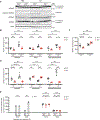Mineralocorticoid Receptor Antagonists Cause Natriuresis in the Absence of Aldosterone
- PMID: 35506380
- PMCID: PMC9177775
- DOI: 10.1161/HYPERTENSIONAHA.122.19159
Mineralocorticoid Receptor Antagonists Cause Natriuresis in the Absence of Aldosterone
Abstract
Background: MR (mineralocorticoid receptor) antagonists are recommended for patients with resistant hypertension even when circulating aldosterone levels are not high. Although aldosterone activates MR to increase epithelial sodium channel (ENaC) activity, glucocorticoids also activate MR but are metabolized by 11βHSD2 (11β-hydroxysteroid dehydrogenase type 2). 11βHSD2 is expressed at increasing levels from distal convoluted tubule (DCT) through collecting duct. Here, we hypothesized that MR maintains ENaC activity in the DCT2 and early connecting tubule in the absence of aldosterone.
Methods: We studied AS (aldosterone synthase)-deficient (AS-/-) mice, which were backcrossed onto the same C57BL6/J strain as kidney-specific MR knockout (KS-MR-/-) mice. KS-MR-/- mice were used to compare MR expression and ENaC localization and cleavage with AS-/- mice.
Results: MR was highly expressed along DCT2 through the cortical collecting duct (CCD), whereas no 11βHSD2 expression was observed along DCT2. MR signal and apical ENaC localization were clearly reduced along both DCT2 and CCD in KS-MR-/- mice but were fully preserved along DCT2 and were partially reduced along CCD in AS-/- mice. Apical ENaC localization and ENaC currents were fully preserved along DCT2 in AS-/- mice and were not increased along CCD after low salt. AS-/- mice exhibited transient Na+ wasting under low-salt diet, but administration of the MR antagonist eplerenone to AS-/- mice led to hyperkalemia and decreased body weight with higher Na+ excretion, mimicking the phenotype of MR-/- mice.
Conclusions: Our results provide evidence that MR is activated in the absence of aldosterone along DCT2 and partially CCD, suggesting glucocorticoid binding to MR preserves sodium homeostasis along DCT2 in AS-/- mice.
Keywords: aldosterone; cortisol; hypertension; ion channels, sodium; mice.
Conflict of interest statement
Disclosures
The authors have no conflicts of interest to declare.
Figures






References
-
- Williams B, MacDonald TM, Morant S, Webb DJ, Sever P, McInnes G, Ford I, Cruickshank JK, Caulfield MJ, Salsbury J, et al. Spironolactone versus placebo, bisoprolol, and doxazosin to determine the optimal treatment for drug-resistant hypertension (PATHWAY-2): a randomised, double-blind, crossover trial. Lancet. 2015;386:2059–2068. doi: 10.1016/S0140-6736(15)00257-3 - DOI - PMC - PubMed
-
- Williams B, MacDonald TM, Morant SV, Webb DJ, Sever P, McInnes GT, Ford I, Cruickshank JK, Caulfield MJ, Padmanabhan S, et al. Endocrine and haemodynamic changes in resistant hypertension, and blood pressure responses to spironolactone or amiloride: the PATHWAY-2 mechanisms substudies. Lancet Diabetes Endocrinol. 2018;6:464–475. doi: 10.1016/S2213-8587(18)30071-8 - DOI - PMC - PubMed
-
- Parthasarathy HK, Alhashmi K, McMahon AD, Struthers AD, McInnes GT, Ford I, Connell JM, MacDonald TM. Does the ratio of serum aldosterone to plasma renin activity predict the efficacy of diuretics in hypertension? Results of RENALDO. J Hypertens. 2010;28:170–177. doi: 10.1097/HJH.0b013e328332b79b - DOI - PubMed
Publication types
MeSH terms
Substances
Grants and funding
LinkOut - more resources
Full Text Sources
Other Literature Sources
Research Materials

